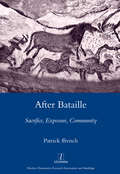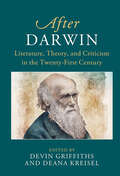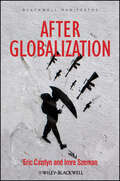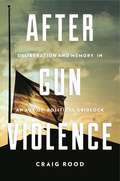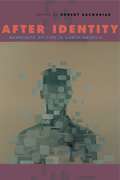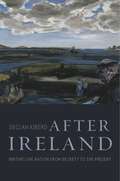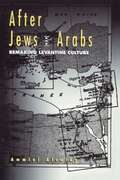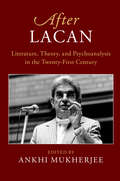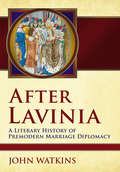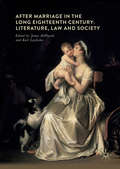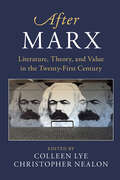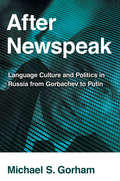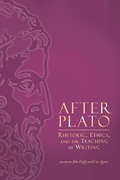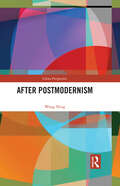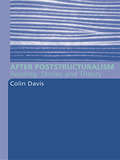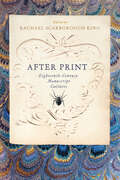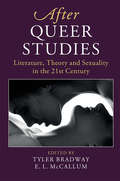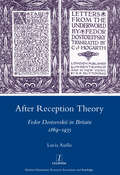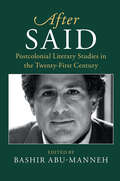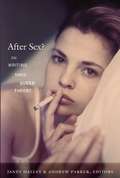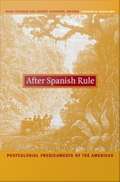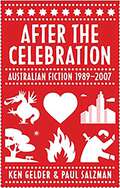- Table View
- List View
After Bataille: Sacrifice, Exposure, Community
by Patrick FfrenchAuthor of the obscene narrative Story of the Eye and of works of heretical philosophy such as Inner Experience, Georges Bataille (1897-1962) is one of the most powerful and secretly influential French thinkers of the last century. His work is driven by a compulsion to communicate an experience which exceeds the limits of communicative exchange, and also constitutes a sustained focus on the nature of this complusion. After Bataille takes this sense of compulsion as its motive and traces it across different figures in Batailles thought, from an obsession with the thematics and the event of sacrifice, through the exposure of being and of the subject, to the necessary relation to others in friendship and in community. In each of these instances After Bataille is distinctive in staging a series of encounters between Bataille, his contemporaries, and critics and theorists who extend or engage with his legacy. It thus offers a vital account of the place of Bataille in contemporary thought.
After Darwin: Literature, Theory, and Criticism in the Twenty-First Century (After Series)
by Devin Griffiths Deanna KreiselCreative storytelling is the beating heart of Darwin's science. All of Darwin's writings drew on information gleaned from a worldwide network of scientific research and correspondence, but they hinge on moments in which Darwin asks his reader to imagine how specific patterns came to be over time, spinning yarns filled with protagonists and antagonists, crises, triumphs, and tragedies. His fictions also forged striking new possibilities for the interpretation of human societies and their relation to natural environments. This volume gathers an international roster of scholars to ask what Darwin's writing offers future of literary scholarship and critical theory, as well as allied fields like history, art history, philosophy, gender studies, disability studies, the history of race, aesthetics, and ethics. It speaks to anyone interested in the impact of Darwin on the humanities, including literary scholars, undergraduate and graduate students, and general readers interested in Darwin's continuing influence.
After Foucault: Culture, Theory, and Criticism in the 21st Century (After Series)
by Lisa DowningThe work of Michel Foucault is much read, widely cited, and occasionally misunderstood. In response to this state of affairs, this collection aims to clarify, to contextualize, and to contribute to Foucauldian scholarship in a very specific way. Rather than offering either a conceptual introduction to Foucault's work, or a series of interventions aimed specifically at experts, After Foucault explores his critical afterlives, situates his work in current debates, and explains his intellectual legacy. As well as offering up-to-date assessments of Foucault's ongoing use in fields such as literary studies, sexuality studies, and history, chapters explore his relevance for urgent and emerging disciplines and debates, including ecology, animal studies, and the analysis of neoliberalism. Written in an accessible style, by leading experts, After Foucault demonstrates a commitment to taking seriously the work of a key twentieth-century thinker for contemporary academic disciplines, political phenomena, and cultural life.
After Globalization
by Eric Cazdyn Imre SzemanIn lively and unflinching prose, Eric Cazdyn and Imre Szeman argue that contemporary thought about the world is disabled by a fatal flaw: the inability to think "an after" to globalization. After establishing seven theses (on education, morality, history, future, capitalism, nation, and common sense) that challenge the false promises that sustain this time-limit, After Globalization examines four popular thinkers (Thomas Friedman, Richard Florida, Paul Krugman and Naomi Klein) and how their work is dulled by these promises. Cazdyn and Szeman then speak to students from around the globe who are both unconvinced and uninterested in these promises and who understand the world very differently than the way it is popularly represented.After Globalization argues that a true capacity to think an after to globalization is the very beginning of politics today.
After Gun Violence: Deliberation and Memory in an Age of Political Gridlock (Rhetoric and Democratic Deliberation #21)
by Craig RoodMass shootings have become the “new normal” in American life. The same can be said for the public debate that follows a shooting: blame is cast, political postures are assumed, but no meaningful policy changes are enacted. In After Gun Violence, Craig Rood argues that this cycle is the result of a communication problem. Without advocating for specific policies, Rood examines how Americans talk about gun violence and suggests how we might discuss the issues more productively and move beyond our current, tragic impasse.Exploring the ways advocacy groups, community leaders, politicians, and everyday citizens talk about gun violence, Rood reveals how the gun debate is about far more than just guns. He details the role of public memory in shaping the discourse, showing how memories of the victims of gun violence, the Second Amendment, and race relations influence how gun policy is discussed. In doing so, Rood argues that forgetting and misremembering this history leads interest groups and public officials to entrenched positions and political failure and drives the public further apart.Timely and innovative, After Gun Violence advances our understanding of public discourse in an age of gridlock by illustrating how public deliberation and public memory shape and misshape one another. It is a search to understand why public discourse fails and how we can do better.
After Gun Violence: Deliberation and Memory in an Age of Political Gridlock (Rhetoric and Democratic Deliberation)
by Craig RoodMass shootings have become the “new normal” in American life. The same can be said for the public debate that follows a shooting: blame is cast, political postures are assumed, but no meaningful policy changes are enacted. In After Gun Violence, Craig Rood argues that this cycle is the result of a communication problem. Without advocating for specific policies, Rood examines how Americans talk about gun violence and suggests how we might discuss the issues more productively and move beyond our current, tragic impasse.Exploring the ways advocacy groups, community leaders, politicians, and everyday citizens talk about gun violence, Rood reveals how the gun debate is about far more than just guns. He details the role of public memory in shaping the discourse, showing how memories of the victims of gun violence, the Second Amendment, and race relations influence how gun policy is discussed. In doing so, Rood argues that forgetting and misremembering this history leads interest groups and public officials to entrenched positions and political failure and drives the public further apart.Timely and innovative, After Gun Violence advances our understanding of public discourse in an age of gridlock by illustrating how public deliberation and public memory shape and misshape one another. It is a search to understand why public discourse fails and how we can do better.
After Identity: Mennonite Writing in North America
by Robert ZachariasFor decades, the field of Mennonite literature has been dominated by the question of Mennonite identity. After Identity interrogates this prolonged preoccupation and explores the potential to move beyond it to a truly post-identity Mennonite literature. The twelve essays collected here view Mennonite writing as transitioning beyond a tradition concerned primarily with defining itself and its cultural milieu. What this means for the future of Mennonite literature and its attendant criticism is the question at the heart of this volume. Contributors explore the histories and contexts—as well as the gaps—that have informed and diverted the perennial focus on identity in Mennonite literature, even as that identity is reread, reframed, and expanded.After Identity is a timely reappraisal of the Mennonite literature of Canada and the United States at the very moment when that literature seems ready to progress into a new era.In addition to the editor, the contributors are Ervin Beck, Di Brandt, Daniel Shank Cruz, Jeff Gundy, Ann Hostetler, Julia Spicher Kasdorf, Royden Loewen, Jesse Nathan, Magdalene Redekop, Hildi Froese Tiessen, and Paul Tiessen.
After Ireland: Writing the Nation from Beckett to the Present
by Declan KiberdPolitical failures and globalization have eroded Ireland’s sovereignty—a decline portended in Irish literature. Surveying the bleak themes in thirty works by modern writers, Declan Kiberd finds audacious experimentation that embodies the defiance and resourcefulness of Ireland’s founding spirit—and a strange kind of hope for a more open nation.
After Jews and Arabs: Remaking Levantine Culture
by Ammiel AlcalayThis book not only makes a significant contribution to the literature but, by breaking new ground, seeks to create a new frame of reference for further studies of the Mediterranean. The author has pulled together many strands of scholarship to present a view of the Middle East that is starkly at odds with that put forth in the establishment press and academic journals - while taking care not to sacrifice the erudition and research, whether literary critical, historical or linguistic, that have traditionally sanctioned the orientalists' version of Levantine history in the service of Western control over the region.
After Lacan: Literature, Theory and Psychoanalysis in the 21st Century (After Series)
by Ankhi MukherjeeThis book draws on the distinct phases of Jacques Lacan's career to show his way of thinking in and beyond his lifetime. It is an examination of the past, present, and futures of psychoanalysis, as these are developed beyond in the dimensions of language, literature, logic, philosophy, visual culture, identity and sexuality, and politics. The interdisciplinary approach of the volume allows it to work across clinical, sociological, philosophical, and literary fields to both add dimensions to the literary/critical reception of Lacan and enable the system of Lacanian psychoanalysis to have a wider conversation. Re-examining the fundamental concepts of Lacanian theory in its historical contexts through the topological structures he inaugurated, After Lacan makes innovative critical interventions in contemporary debates on racism, Islam, the Communist Party, poetry, new media, disability identity, and queer theory. It is a key resource for students, graduates ad instructors of literary theory, psychoanalysis, and the works of Lacan.
After Lavinia: A Literary History of Premodern Marriage Diplomacy
by John WatkinsThe Renaissance jurist Alberico Gentili once quipped that, just like comedies, all wars end in a marriage. In medieval and early modern Europe, marriage treaties were a perennial feature of the diplomatic landscape. When one ruler decided to make peace with his enemy, the two parties often sealed their settlement with marriages between their respective families. In After Lavinia, John Watkins traces the history of the practice, focusing on the unusually close relationship between diplomacy and literary production in Western Europe from antiquity through the seventeenth century, when marriage began to lose its effectiveness and prestige as a tool of diplomacy.Watkins begins with Virgil's foundational myth of the marriage between the Trojan hero Aeneas and the Latin princess, an account that formed the basis for numerous medieval and Renaissance celebrations of dynastic marriages by courtly poets and propagandists. In the book's second half, he follows the slow decline of diplomatic marriage as both a tool of statecraft and a literary subject, exploring the skepticism and suspicion with which it was viewed in the works of Spenser and Shakespeare. Watkins argues that the plays of Corneille and Racine signal the passing of an international order that had once accorded women a place of unique dignity and respect.
After Marriage in the Long Eighteenth Century: Literature, Law and Society
by Jenny DiPlacidi Karl LeydeckerThis book examines the intersections between the ways that marriage was represented in eighteenth-century writing and art, experienced in society, and regulated by law. The interdisciplinary and comparative essays explore the marital experience beyond the 'matrimonial barrier' to encompass representations of married life including issues of spousal abuse, parenting, incest, infidelity and the period after the end of marriage, to include annulment, widowhood and divorce. The chapters range from these focuses on legal and social histories of marriage to treatments of marriage in eighteenth-century periodicals, to depictions of married couples and families in eighteenth-century art, to parallels in French literature and diaries, to representations of violence and marriage in Gothic novels, and to surveys of same-sex partnerships. The volume is aimed towards students and scholars working in the long eighteenth century, gender studies, women's writing, publishing history, and art and legal historians.
After Marx: Literature, Theory, and Value in the Twenty-First Century (After Series)
by Colleen Lye Christopher NealonAfter Marx:Literature, Theory and Value demonstrates the importance of Marxist literary and cultural criticism for an era of intersectional politics and economic decline. The volume includes fresh approaches to reading poetry, fiction, film and drama, from Shakespeare to contemporary literature, and shows how Marxist literary criticism improves our understanding of racial capitalism, feminist politics, colonialism, deindustrialization, high-tech labor, ecological crisis, and other issues. A key innovation of the volume's essays is how they attend to Marx's theory of value. For Marx, capitalist value demands a range of different kinds of labor as well as unemployment. This book shows the importance of Marxist approaches to literature that reach beyond simply demonstrating the revolutionary potential or the political consciousness of a 19th-century-style industrial working class. After Marx makes an argument for the twenty-first century interconnectedness of widely different literary genres, and far-flung political struggles.
After Newspeak: Language Culture and Politics in Russia from Gorbachev to Putin
by Michael S. GorhamIn After Newspeak, Michael S. Gorham presents a cultural history of the politics of Russian language from Gorbachev and glasnost to Putin and the emergence of new generations of Web technologies. Gorham begins from the premise that periods of rapid and radical change both shape and are shaped by language. He documents the role and fate of the Russian language in the collapse of the USSR and the decades of reform and national reconstruction that have followed. Gorham demonstrates the inextricable linkage of language and politics in everything from dictionaries of profanity to the flood of publications on linguistic self-help, the speech patterns of the country's leaders, the blogs of its bureaucrats, and the official programs promoting the use of Russian in the so-called "near abroad."Gorham explains why glasnost figured as such a critical rhetorical battleground in the political strife that led to the Soviet Union's collapse and shows why Russians came to deride the newfound freedom of speech of the 1990s as little more than the right to swear in public. He assesses the impact of Medvedev's role as Blogger-in-Chief and the role Putin's vulgar speech practices played in the restoration of national pride. And he investigates whether Internet communication and new media technologies have helped to consolidate a more vibrant democracy and civil society or if they serve as an additional resource for the political technologies manipulated by the Kremlin.
After Plato: Rhetoric, Ethics, and the Teaching of Writing
by John Duffy Lois AgnewAfter Plato redefines the relationships of rhetoric for scholars, teachers, and students of rhetoric and writing in the twenty-first century. Featuring essays by some of the most accomplished scholars in the field, the book explores the diversity of ethical perspectives animating contemporary writing studies—including feminist, postmodern, transnational, non-Western, and virtue ethics—and examines the place of ethics in writing classrooms, writing centers, writing across the curriculum programs, prison education classes, and other settings. When truth is subverted, reason is mocked, racism is promoted, and nationalism takes center stage, teachers and scholars of writing are challenged to articulate the place of rhetorical ethics in the writing classroom and throughout the field more broadly. After Plato demonstrates the integral place of ethics in writing studies and provides a roadmap for future conversations about ethical rhetoric that will play an essential role in the vitality of the field. Contributors: Fred Antczak, Patrick W. Berry, Vicki Tolar Burton, Rasha Diab, William Duffy, Norbert Elliot, Gesa E. Kirsch, Don J. Kraemer, Paula Mathieu, Robert J. Mislevy, Michael A. Pemberton, James E. Porter, Jacqueline Jones Royster, Xiaoye You, Bo Wang
After Postmodernism (China Perspectives)
by Wang NingThis book engages with the critical decline of postmodernism and newer currents of thinking that have come to the fore, including postcolonialism, feminism, and cultural studies, constituting an exploration of the cultural landscape after the heyday of postmodernism in the West and its profound influence on the Chinese cultural scene.Topics discussed include the prevalent theoretical trends and cultural phenomena in the West in the wake of postmodernism, how these developments have influenced contemporary Chinese literary and cultural criticism, and how Chinese scholars can have an equal dialogue with the dominant Western theorists. The chapters examine critical issues and figures in the fields, including postmodernity and globalization, as well as the theories of Edward Said, Gayatri Spivak, Homi Bhabha, and Judith Butler. Taking a comparative and cross-cultural perspective, especially between China and the West, the title also sheds light on the imprint of Western theoretical trends on the literature and culture of contemporary China, exemplified in diasporic writing, cinema, women’s literature, popular culture, and the overall orientation of contemporary Chinese literature.The book will be a critical reference for all levels of reader interested in postmodernism, critical theory, postcolonialism, feminism, cultural studies, comparative and world literature, and contemporary Chinese literature and culture.
After Poststructuralism: Reading, Stories, Theory
by Colin DavisIn the last decades of the twentieth century, French poststructuralist 'theory' transformed the humanities; it also met with resistance and today we frequently hear that theory is 'dead'.In this brilliantly argued volume, Colin Davis:*reconsiders key arguments for and against theory, identifying significant misreadings*reassesses the contribution of poststructuralist thought to the critical issues of knowledge, ethics, hope and identity*sheds new light on the work of Jean-François Lyotard, Emmanuel Levinas, Louis Althusser and Julia Kristeva in a stunning series of readings*offers a fresh perspective on recent debates around the death of theory.In closing he argues that theory may change, but it will not go away. After poststructuralism, then, comes the afterlife of poststructuralism.Wonderfully accessible, this is an account of the past and present fortunes of theory, suitable for anyone researching, teaching, or studying in the field. And yet it is much more than this. Colin Davis provides a way forward for the humanities - a way forward in which theory will play a crucial part.
After Print: Eighteenth-Century Manuscript Cultures
by Michelle Levy Beth Fowkes Tobin Rachael Scarborough King Philip S. Palmer Leith Davis Brian Rejack Margaret J. M. Ezell Emily C. Friedman Collin Jennings Kathryn R. King Marissa Nicosia Colin T. Ramsey Andrew O. WincklesThe eighteenth century has generally been understood as the Age of Print, when the new medium revolutionized the literary world and rendered manuscript culture obsolete. After Print, however, reveals that the story isn’t so simple. Manuscript remained a vital, effective, and even preferred forum for professional and amateur authors working across fields such as literature, science, politics, religion, and business through the Romantic period.The contributors to this book offer a survey of the manuscript culture of the time, discussing handwritten culinary recipes, the poetry of John Keats, Benjamin Franklin’s letters about his electrical experiments, and more. Collectively, the essays demonstrate that what has often been seen as the amateur, feminine, and aristocratic world of handwritten exchange thrived despite the spread of the printed word. In so doing, they undermine the standard print-manuscript binary and advocate for a critical stance that better understands the important relationship between the media.Bringing together work from literary scholars, librarians, and digital humanists, the diverse essays in After Print offer a new model for archival research, pulling from an exciting variety of fields to demonstrate that manuscript culture did not die out but, rather, may have been revitalized by the advent of printing.Contributors: Leith Davis, Simon Fraser University * Margaret J. M. Ezell, Texas A&M University * Emily C. Friedman, Auburn University * Kathryn R. King, University of Montevallo * Michelle Levy, Simon Fraser University * Marissa Nicosia, Penn State Abington * Philip S. Palmer, Morgan Library and Museum * Colin T. Ramsey, Appalachian State University * Brian Rejack, Illinois State University * Beth Fowkes Tobin, University of Georgia * Andrew O. Winckles, Adrian College
After Queer Studies: Literature, Theory and Sexuality in the 21st Century (After Series)
by Tyler Bradway E. L. McCallumAfter Queer Studies maps the literary influences that facilitated queer theory's academic emergence and charts the trajectories that continue to shape its continued evolution as a critical practice. It explores the interdisciplinary origins of queer studies and argues for the prominent role that literary studies has played in establishing the concepts, methods, and questions of contemporary queer theory. It shows how queer studies has had an impact on many trending concerns in literary studies, such as the affective turn, the question of the subject, and the significance of social categories like race, class, and sexual differences. Bridging between queer studies' legacies and its horizons, this collection initiates new discussion on the irreducible changes that queer studies has introduced in the concepts, methods, and modes of literary interpretation and cultural practices.
After Reception Theory: Fedor Dostoevskii in Britain, 1869-1935
by Lucia Dr Aiello"More often than not, monographs on the reception of an author are either detailed, chronologically organised accounts of the reputation of that author, or studies in literary influence. This study adopts neither of those approaches and deals with the reception of Fedor Dostoevskii in Britain from a double perspective. The detailed analysis of primary sources such as reviews, essays and monographs on Dostoevskii is associated here with a critical investigation of the dynamics of the reception process. On the one hand, the available sources are examined with the intention of exposing their underlying ideological tensions and impact on British literary circles. On the other hand, Fedor Dostoevskii's novels are shown to function as a prism, through which significant aspects of nineteenth- and early twentieth-century British intellectual life are refracted. In the final analysis, by using Dostoevskii as an exemplary case study, this book develops both a methodology that aims at clarifying what we mean when we refer to 'reception' and a theoretical alternative to prevalent notions of reception."
After Said: Postcolonial Literary Studies in the Twenty-First Century (After Series)
by Bashir Abu-MannehBy the time of his death in 2003, Edward Said was one of the most famous literary critics of the twentieth century. Said's work has been hugely influential far beyond academia. As a prominent advocate for the Palestinian cause and noted cultural critic, Said redefined the role of the public intellectual. This volume explores the problems and opportunities afforded by Said's work: its productive and generative capacities as well as its in-built limitations. After Said captures the essence of Said's intellectual and political contribution and his extensive impact on postcolonial studies. It examines his legacy by critically elaborating his core concepts and arguments. Among the issues it tackles are humanism, Orientalism, culture and imperialism, exile and the contrapuntal, realism and postcolonial modernism, world literature, Islamophobia, and capitalism and the political economy of empire. It is an excellent resource for students, graduates and instructors studying postcolonial literary theory and the works of Said.
After Sex?: On Writing Since Queer Theory
by Janet Halley Andrew ParkerSince queer theory originated in the early 1990s, its insights and modes of analysis have been taken up by scholars across the humanities and social sciences. In After Sex? prominent contributors to the development of queer studies offer personal reflections on the field's history, accomplishments, potential, and limitations. They consider the purpose of queer theory and the extent to which it is or is not defined by its engagement with sex and sexuality. For many of the contributors, a broad notion of sexuality is essential to queer thought. At the same time, some of them caution against creating an all-embracing idea of queerness, because it empties the term "queer" of meaning and assumes the universality of ideas developed in the North American academy. Some essays recall the political urgency of the late 1980s and early 1990s, when gay and lesbian activist and queer theory projects converged in response to the AIDS crisis. Other pieces exemplify more recent trends in queer critique, including the turn to affect and the debates surrounding the "antisocial thesis," which associates queerness with the repudiation of heteronormative forms of belonging. Contributors discuss queer theory's engagement with questions of transnationality and globalization, temporality and historical periodization. Meditating on the past and present of queer studies, After Sex? illuminates its future. Contributors. Lauren Berlant, Leo Bersani, Michael Cobb, Ann Cvetkovich, Lee Edelman, Richard Thompson Ford, Carla Freccero, Elizabeth Freeman, Jonathan Goldberg, Janet Halley, Neville Hoad, Joseph Litvak, Heather Love, Michael Lucey, Michael Moon, Jos Esteban Muoz, Jeff Nunokawa, Andrew Parker, Elizabeth A. Povinelli, Richard Rambuss, Erica Rand, Bethany Schneider, Eve Kosofsky Sedgwick, Kate Thomas
After Spanish Rule: Postcolonial Predicaments of the Americas
by Mark Thurner Andrés GuerreroInsisting on the critical value of Latin American histories for recasting theories of postcolonialism, After Spanish Rule is the first collection of essays by Latin Americanist historians and anthropologists to engage postcolonial debates from the perspective of the Americas. These essays extend and revise the insights of postcolonial studies in diverse Latin American contexts, ranging from the narratives of eighteenth-century travelers and clerics in the region to the status of indigenous intellectuals in present-day Colombia. The editors argue that the construction of an array of singular histories at the intersection of particular colonialisms and nationalisms must become the critical project of postcolonial history-writing. Challenging the universalizing tendencies of postcolonial theory as it has developed in the Anglophone academy, the contributors are attentive to the crucial ways in which the histories of Latin American countries--with their creole elites, hybrid middle classes, subordinated ethnic groups, and complicated historical relationships with Spain and the United States--differ from those of other former colonies in the southern hemisphere. Yet, while acknowledging such differences, the volume suggests a host of provocative, critical connections to colonial and postcolonial histories around the world. Contributors Thomas Abercrombie Shahid Amin Jorge Caizares-Esguerra Peter Guardino Andrs Guerrero Marixa Lasso Javier Morillo-Alicea Joanne Rappaport Mauricio Tenorio-Trillo Mark Thurner
After The Celebration: Australian Fiction 1989-2007
by Paul Salzman Ken GelderAfter the Celebration explores Australian fiction from 1989 to 2007, after Australia's bicentenary to the end of the Howard government. In this literary history, Ken Gelder and Paul Salzman combine close attention to Australian novels with a vivid depiction of their contexts: cultural, social, political, historical, national and transnational. From crime fiction to the postmodern colonial novel, from Australian grunge to 'rural apocalypse fiction', from the Asian diasporic novel to the action blockbuster, Gelder and Salzman show how Australian novelists such as Frank Moorhouse, Elizabeth Jolley, Peter Carey, Kim Scott, Steven Carroll, Kate Grenville, Tim Winton, Alexis Wright and many others have used their work to chart our position in the world. The literary controversies over history, identity, feminism and gatekeeping are read against the politics of the day. Provocative and compelling, After the Celebration captures the key themes and issues in Australian fiction: where we have been and what we have become.
